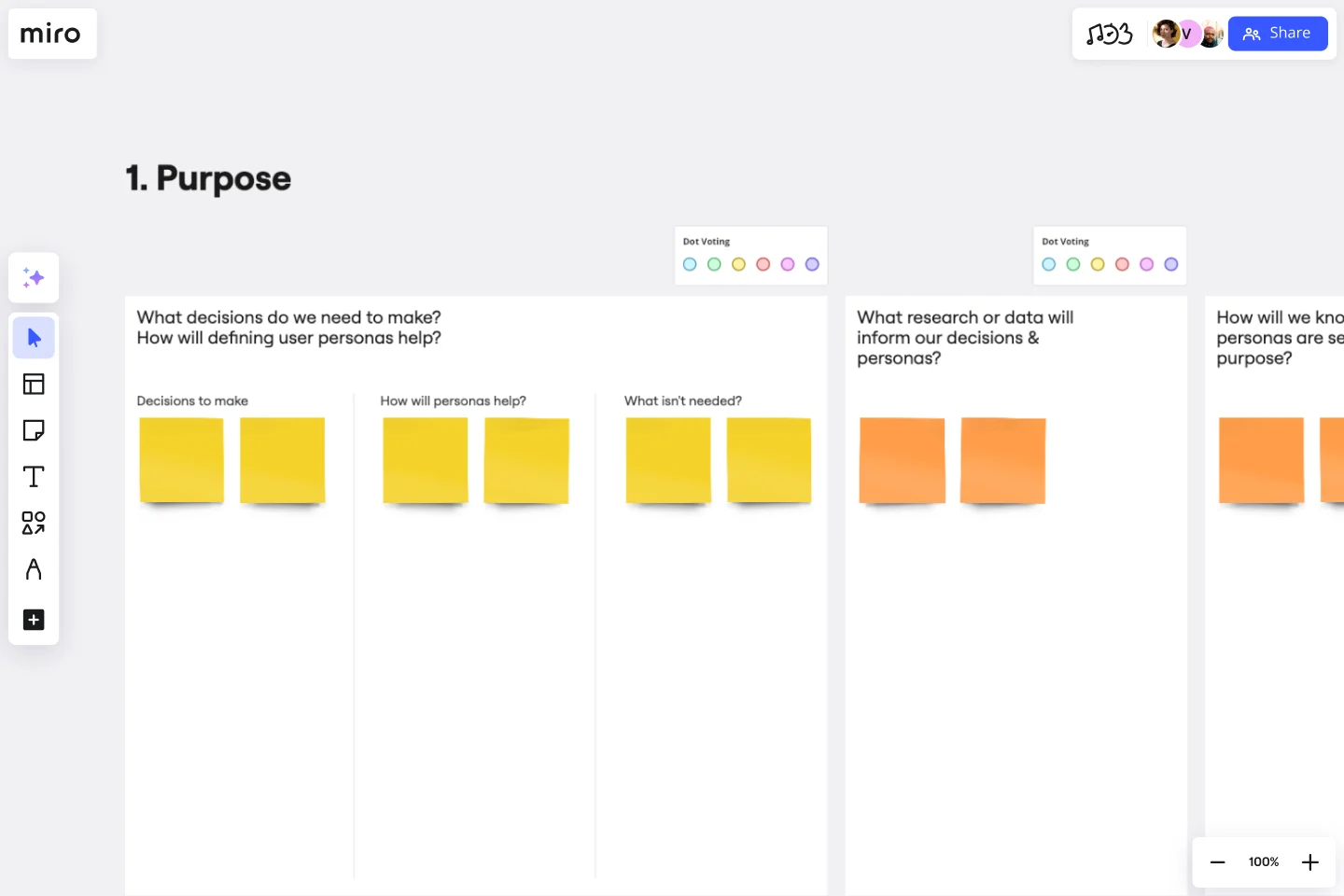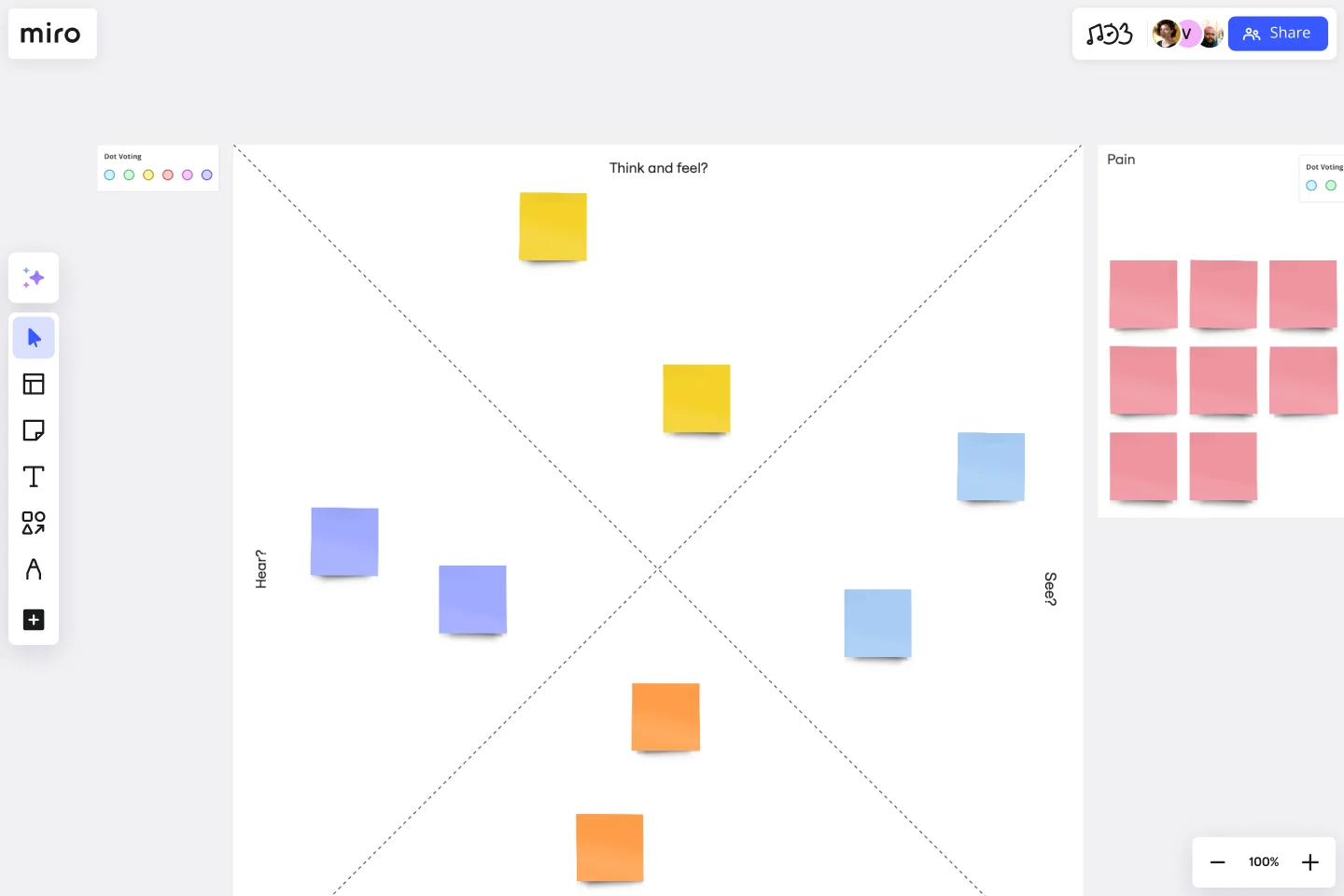
Table of contents
Table of contents
Target audience examples: a complete guide to understanding your customers

Summary
In this guide, you will learn how to:
- Define target audience using various persona types.
- Capture demographics, behaviors, motivations, and challenges for detailed audience profiles.
- Collect and organize demographic and location data to visualize audience.
- Identify audience needs to tailor value propositions, improve UX, and develop products.
- Use persona templates to enhance marketing, product development, team communication, and strategic decisions.
- Utilize Miro and other tools for persona creation, including empathy maps and tagging templates.
Try Miro now
Join thousands of teams using Miro to do their best work yet.
You can’t market effectively if you don’t know who you’re speaking to. Defining your target audience isn’t just a step in your strategy—it’s the cornerstone of your success. Whether you’re crafting campaigns, developing products, or planning your next big launch, a well-defined target audience will steer you in the right direction. Let’s explore what a target audience is, how to define one, and target audience examples to inspire your next project.
What’s a target audience?
Your target audience is the group of people most likely to engage with your product, service, or content. They’re the people you want to reach because their needs, goals, and behaviors align closely with what you offer.
But a target audience is more than a general category—it’s a dynamic, multi-layered profile made up of several key components:
Demographics: These are the basics, like age, gender, location, education, and occupation. Think of this as the foundation for understanding who your audience is on paper.
Psychographics: Go beyond the surface by considering values, lifestyles, hobbies, and beliefs. Psychographics tell you why your audience behaves the way they do.
Behavioral traits: What actions does your audience take? This could include their buying habits, preferred shopping methods, or the kind of content they engage with online.
Pain points: What challenges or problems does your audience face? These frustrations are opportunities for your product or service to shine.
Goals and aspirations: What does your audience want to achieve? These insights help you connect emotionally and position your product as a stepping stone toward their ambitions.
Understanding all these elements creates a vivid, actionable picture of your ideal audience—and helps you craft messaging, products, and experiences that resonate on a deeper level.
How do you define your target audience?
Defining your target audience doesn’t have to be overwhelming. By following a clear, step-by-step process, you can gather the insights needed to zero in on the people who matter most to your business.
1. Start with your product or service
Begin by identifying what your product or service does and the problems it solves. Ask yourself: Who benefits most from what we’re offering?
For example, if you’re offering time-management software, your ideal audience might include professionals juggling deadlines, project managers coordinating teams, or freelancers looking for better workflows.
Pro tip: Split your audience into primary and secondary groups. Your primary audience is the direct user, while secondary audiences might influence the purchasing decision (like managers or procurement teams).
2. Dig into your data
Your existing data is a goldmine for audience insights. Use analytics tools to uncover patterns and trends among your current customers and followers.
Website analytics: What demographics visit your site? Which pages and content resonate most?
Social media engagement: Which platforms drive the most interaction, and what type of content sparks conversations?
Purchase data: What products or services are your customers gravitating toward?
Pair these quantitative insights with qualitative methods like surveys and customer interviews to uncover the “why” behind the numbers.
Pro tip: Use open-ended questions in surveys to capture unique perspectives that data alone can’t provide.
3. Research your market
Your audience exists within a broader market context. Researching competitors, trends, and gaps can help you position your product uniquely.
Study your competitors: Who are they targeting, and how? Look for opportunities to serve audiences they might be missing.
Track trends: Industry shifts can reveal new needs or highlight underserved niches.
Pro tip: Explore communities like forums, social media groups, or industry events to see what’s top-of-mind for your potential audience.
4. Build personas
Personas bring your audience to life. A strong persona includes:
- Demographics
- Motivations and goals
- Pain points
- Decision-making factors
- Communication preferences
Personas make your audience tangible, helping your team focus on real people rather than abstract numbers. With clear personas, you’ll find it easier to craft messages, campaigns, and products that hit the mark.
When do you need a target audience?
A defined target audience is critical at nearly every stage of your business strategy. Let’s look at how it can guide you:
Creating personalized marketing campaigns: Knowing your audience allows you to speak their language. Whether you’re running social ads or sending emails, targeting the right people with the right message leads to higher engagement and better results.
Prioritizing product features or updates: Not all features resonate equally. By understanding your audience’s needs, you can focus on creating solutions that add the most value, saving time and resources.
Choosing the right distribution channels: Your target audience determines where you invest your energy. For example, B2B audiences may prefer LinkedIn, while younger consumers might spend more time on TikTok or Instagram.
Developing impactful messaging: A generic message might reach many, but it rarely connects. Tailored messaging based on your target audience’s values, pain points, and goals creates a lasting impression.
In every scenario, your target audience acts as a guide, ensuring your efforts are focused and effective.
Target audience examples in Miro
Now let’s put theory into practice. In this section, we’ll explore different ways to define your audience and how Miro can help bring it to life.
Target audience

Start with the basics with this target audience template. Define your audience by demographics, behaviors, and interests. This is your high-level overview—great for ensuring you’re aligned on who you’re targeting.
Audience persona

These are more detailed profiles that humanize your audience. An audience persona includes demographics, behaviors, motivations, and challenges. They’re excellent for refining your messaging or creating specific campaigns.
Proto persona

When time is tight, proto personas give you a quick snapshot of your audience. They’re not as detailed as full personas but still help your team stay aligned.
User persona

If you’re building a digital product or service, user personas go beyond general traits and dive into specific user behaviors and needs. They’re especially helpful for UX and product design teams.
Other frameworks to help you shape your strategy
Once you’ve defined your target audience, these frameworks can help you sharpen your approach:
Brand positioning

Where does your product sit in the market? Understanding your brand positioning can help you refine your messaging to connect with your audience.
Go-to-market plan

This GTM framework ensures you’re targeting the right audience with the right strategy when launching a product or service.
Empathy map

Step into your audience’s shoes. An empathy map template helps you understand what your audience thinks, feels, says, and does—giving you deeper insight into their motivations.
Tips on how to build your target audience according to your project’s needs
Building your target audience is a skill that improves with time and practice. Here’s how to approach it thoughtfully:
Start with small, actionable steps
Focus on one audience segment at a time. By targeting a specific group, you can test strategies, gather insights, and refine your approach before expanding.
Balance data and intuition
Quantitative data provides clarity, but don’t underestimate the power of intuition. Real-world observations and market experience can help fill gaps in your understanding.
Adapt as you learn
Audiences evolve. Regularly revisit your personas and data to stay aligned with their changing needs and preferences.
Collaborate for a 360° view
Involve teams across your organization—sales, product, customer support. Each brings unique insights that enrich your understanding of the target audience.
Visualize your insights
Bring your audience to life visually with Miro. Map out personas, behaviors, and pain points to create a shared understanding across teams.
With these tips, you’ll build a robust foundation for your projects and campaigns.
Create unique user experiences with Miro
When you deeply understand your audience, you can deliver experiences that feel personal, relevant, and impactful. A well-defined target audience allows you to craft meaningful connections, build products that solve real problems, and deliver campaigns that drive results. These insights not only foster stronger relationships but also lead to better business outcomes.
Miro’s ready-made templates, powerful collaboration features, and intuitive Miro AI make it the perfect tool for helping you define and visualize your audience. From brainstorming personas to refining strategies, Miro ensures your team stays aligned, whether you’re collaborating in real time or asynchronously.
Ready to start building strategies that resonate? Explore Miro’s target audience templates today and take the first step toward creating products and campaigns that truly connect.
Author: Miro Team
Last update: October 14, 2025